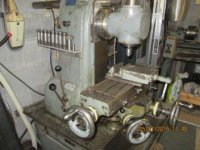Delrin
Plastic
- Joined
- Oct 14, 2018
- Location
- Montreal, Canada
Hi -
New member here.
For some time I've been looking for a Hardinge TM mill to augment my metal fabrication capabilities at home. We have a machine shop at work, and while I've had some basic training I have a lot to learn and am not really in a position to critically assess an old mill.
So I'm basically viewing this as a learning experience, and understand that there is some risk and a fair bit of work/expense involved.
Space is very tight in my home shop, and the Hardinge TM/UM seems to be the best bet in terms of footprint and capabilities. After looking for several months, it seems these are somewhat sought after and there are not many in my area (Montreal, Canada).
Recently, a local unit came up for sale in my city and I'm prepared to go for it.
The description in the advert lists the following features:
The current owner believes it is wired to run at 110V or 220V. I attached a couple of pictures from the advert, for what it's worth.
I've searched and read various articles in this forum and elsewhere, which have been quite helpful. I'd be grateful for any comments the more knowledgable members can provide on this mill. I may be able to get an experienced machinist from work to come and help assess, but curious what responses I might get here.
I'm not sure I want to get into a discussion of the asking price here, as this depends on the local market. I've been looking at used mills across Canada for several months and the asking price seems within the market range.
Thanks in advance,
D
New member here.
For some time I've been looking for a Hardinge TM mill to augment my metal fabrication capabilities at home. We have a machine shop at work, and while I've had some basic training I have a lot to learn and am not really in a position to critically assess an old mill.
So I'm basically viewing this as a learning experience, and understand that there is some risk and a fair bit of work/expense involved.
Space is very tight in my home shop, and the Hardinge TM/UM seems to be the best bet in terms of footprint and capabilities. After looking for several months, it seems these are somewhat sought after and there are not many in my area (Montreal, Canada).
Recently, a local unit came up for sale in my city and I'm prepared to go for it.
The description in the advert lists the following features:
- Universal head divider with related discs
- vertical rotary head with attachment collar for endmill up to 3/4 diameter
- 3 speed
- Horizontal shaft included
- 1 hp engine, voltage 220V
- clamp included.
The current owner believes it is wired to run at 110V or 220V. I attached a couple of pictures from the advert, for what it's worth.
I've searched and read various articles in this forum and elsewhere, which have been quite helpful. I'd be grateful for any comments the more knowledgable members can provide on this mill. I may be able to get an experienced machinist from work to come and help assess, but curious what responses I might get here.
I'm not sure I want to get into a discussion of the asking price here, as this depends on the local market. I've been looking at used mills across Canada for several months and the asking price seems within the market range.
Thanks in advance,
D









